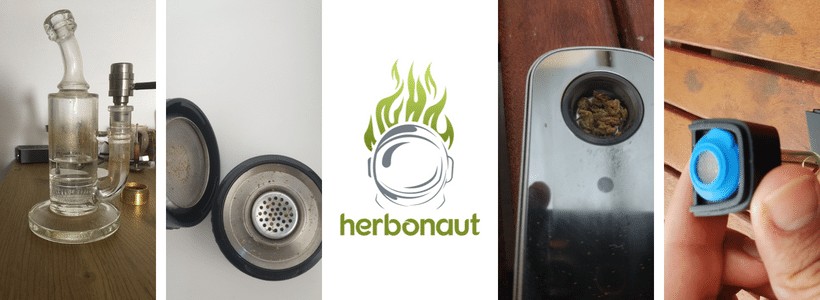
While every dry herb vaporizer has its own optimal cleaning method…
There are general principles to keep in mind when cleaning any vaporizer.
Today, you’re going to learn the general rules to keep in mind when cleaning any vaporizer.
Why is this important?
Because keeping your vaporizer clean won’t only increase its longevity…
But will also reduce health risks.
Let’s get started.
Table of Contents
-
- Why It’s Important to Keep Your Vaporizer Clean for Health Reasons
- Why It’s Important to Keep Your Vaporizer Clean for Increasing Longevity
- Why It’s Important to Keep Your Vaporizer Clean for Taste Preservation
- The Most Effective Tool for Cleaning Your Vaporizer: Isopropyl Alcohol
- Daily Maintenance Works Better than Extensive Cleaning Every Now and Then
Why It’s Important to Keep Your Vaporizer Clean for Health Reasons
When you vape cannabis, your vaporizer doesn’t only produce vapor. But it also produces resin.
What’s resin?
When plant matter gets heated, the compounds inside the plant start heating and/or boiling. This creates new types of compounds called ‘secondary metabolites’. This mix of secondary metabolites is called resin.
When it comes to cannabis resin it’s often viscous, oily, and sticky:
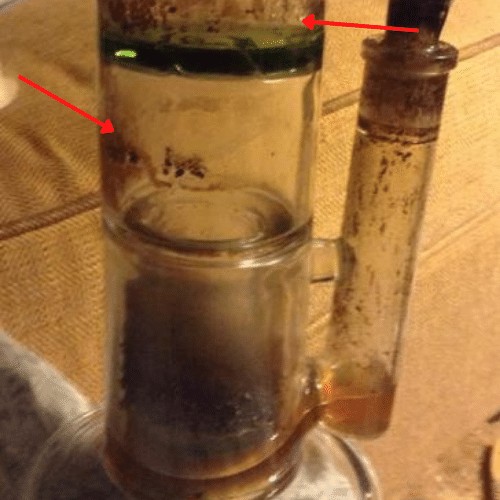
Cannabis resin sticks to various parts of your vaporizer. But mainly the bowl and vapor path.
Now:
Resin itself isn’t necessarily harmful. In fact, you could recollect cannabis resin from your vaporizer with a scraper or alcohol and for example make a tincture out of it.
But even though it isn’t harmful to ingest resin, resin’s acidic properties can pose health risks.
Here’s why:
Most vaporizers have metallic and plastic parts inside their vapor path. Cannabis resin has acidic properties. When metallic or plastic parts get exposed to an acidic mix of compounds like resin, you risk corrosion.
Now:
You don’t have to worry that your parts of your vaporizer will start corroding after leaving resin inside your vaporizer for a few days. That’s not how quickly it goes. But if you leave it there for months, you risk corroding the parts that are exposed to the resin.
When corrosion occurs, the corroded parts may leak microparticles into the vapor path.
Inhaling these leaked microparticles could be a potential health risk.
Some types of materials are more resistant to corrosion than others. Plastic, for example, is less resistant to corrosion than stainless steel. But stainless steel isn’t immune to corrosion.
Glass, for example is immune to corrosion. Different materials inside vaporizers have different safety levels. If you want to learn more about this topic, read up on vaporizer safety.
If you have a full glass vapor path, you don’t have to worry about resin for health reasons. But keep in mind that there are almost no vaporizers with full glass vapor paths. There are almost always ceramic, stainless steel, plastic or silicone parts inside a ‘glass’ vapor path.
A lot of vaporizer manufacturers falsely market their vaporizer as having a ‘glass vapor path’, when in reality only a part of the vapor path is glass.
But even if you have a full glass vapor path, it still would be good to keep your vaporizer clean for other reasons than health.
Why It’s Important to Keep Your Vaporizer Clean for Increasing Longevity
As explained, cannabis resin can corrode the materials inside your vaporizer.
This isn’t only a potential issue for health reasons. But it’s also a potential issue for the longevity of your vaporizer. If parts of your vaporizer start corroding it can compromise the structure and stability of your vaporizer.
For example, plastic parts can start showing cracks:
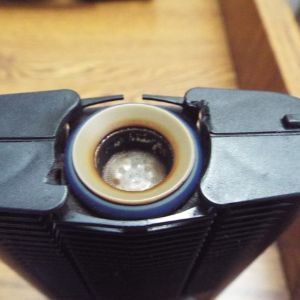
Or metallic parts can start rusting. Especially screens should be cleaned or changed regularly:
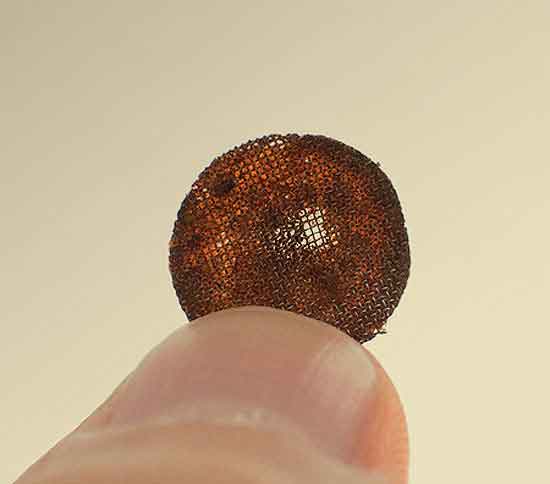
These things will definitely degrade the performance and longevity of your vaporizer.
Why It’s Important to Keep Your Vaporizer Clean for Taste Preservation
Cannabis resin generally doesn’t have the best taste.
What gives cannabis its characteristic taste are terpenes.
But terpenes are volatile compounds that evaporate quickly.
When you heat dry herb, one of the first things that evaporate are terpenes.
So when there’s cannabis resin left inside your vaporizer, it’s safe to say that it contains little to no terpenes.
And if you ever tasted already vaped bud, you will know that cannabis (resin) without terpenes tastes horrible.
If you don’t clean your vaporizer regularly, this bad-tasting resin will be represented inside the vapor you inhale.
But as explained, this resin can corrode the materials inside your vaporizer as well.
For example:
Corroded, rusty metallic parts, of course, will give a very different taste than non-rusty metallic parts. And not for the better.
If you want to keep the taste of your vaporizer as clean as possible, you have to keep it clean.
The Most Effective Tool for Cleaning Your Vaporizer: Isopropyl Alcohol
Alcohol isopropyl alcohol is a very effective tool to clean your vaporizer.
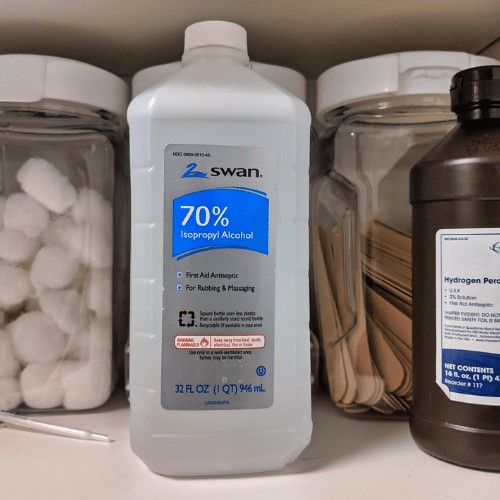
While most vaporizers parts can be cleaned with isopropyl alcohol, not every type of material found in your vaporizer can be soaked in isopropyl alcohol.
Let’s start with the material types that you should avoid soaking in isopropyl alcohol.
Keep in mind that a lot of these materials can be cleaned with isopropyl alcohol. For example, with an isopropyl alcohol-soaked Q-tip. Just don’t soak them inside isopropyl alcohol.
Plastic and acrylic
A lot of vaporizers have one or a few plastic parts. And this doesn’t only hold true for the cheaper vaporizers.
Even some high-end vaporizers like the MIGHTY+ and CRAFTY+ are made from a lot of plastic.

Other than brushing with an isopropyl alcohol-soaked Q-tip, plastic doesn’t go well with isopropyl alcohol. Definitely don’t ever soak plastic parts in isopropyl alcohol. Plastic will definitely degrade if exposed to alcohol for too long.
Acrylic (or plexiglass) is rare in vaporizers. But we’ve encountered acrylic in herb grinders. Don’t ever soak acrylic parts in isopropyl alcohol. It will discolor and degrade.
Wood
While you can clean the inner parts of, for example, a wooden air path in a vaporizer with isopropyl alcohol…
If your wooden parts have a finish, like a lot of exterior parts of wood, it’s better to avoid using alcohol for cleaning those specific parts. Wooden finish can be very sensitive to isopropyl alcohol.
Rubber and silicone
Rubber and silicone don’t handle isopropyl alcohol well.
The most you could do is use an isopropyl alcohol-soaked Q-tip to clean it, but then quickly wash the isopropyl alcohol off with some water.
If you don’t wash it off you may see some discoloration and even deterioration.
Now:
If you soak rubber or silicone in isopropyl alcohol you risk completely dissolving it. So just never do that.
For example, vaporizer whips should never be soaked in isopropyl alcohol:
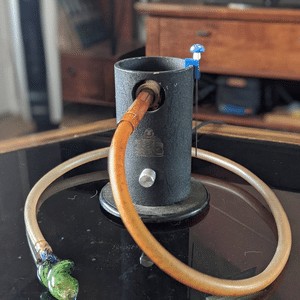
Materials that can be soaked in isopropyl alcohol
Other material types like:
- Stainless steel,
- Glass,
- Ceramic,
Can be soaked in isopropyl alcohol well. They usually don’t need be soaked for longer than 20-30 minutes.
Daily Maintenance Works Better than Extensive Cleaning Every Now and Then
If you let cannabis resin build up inside the bowl and vapor path of your vaporizer, it will be more difficult to clean. Resin is very sticky. Also, if you keep already vaped bud, inside the bowl and vapor path, resin can develop even after you’ve turned your vaporizer off.
So from every perspective quickly brushing resin and already vaped bud out of your bowl and vapor path is the smart way to clean your vaporizer.
This way, you’ll need way less deep cleaning session to keep your vaporizer clean.
It will also save you a good amount of time. Because a quick maintenance session takes only a few minutes. While a deep-cleaning session can take anywhere between 10-30 minutes.
What’s Next…
More vaporizer guides: